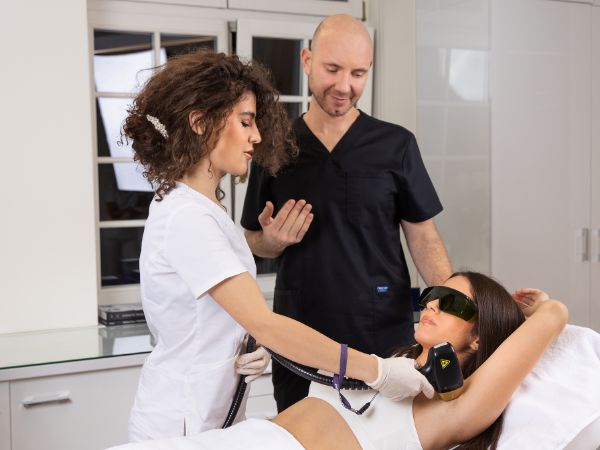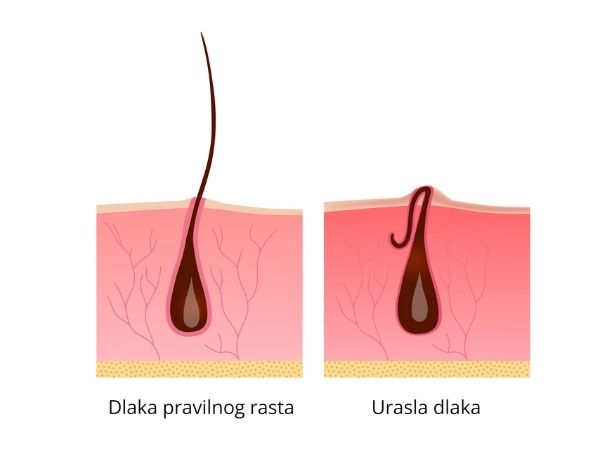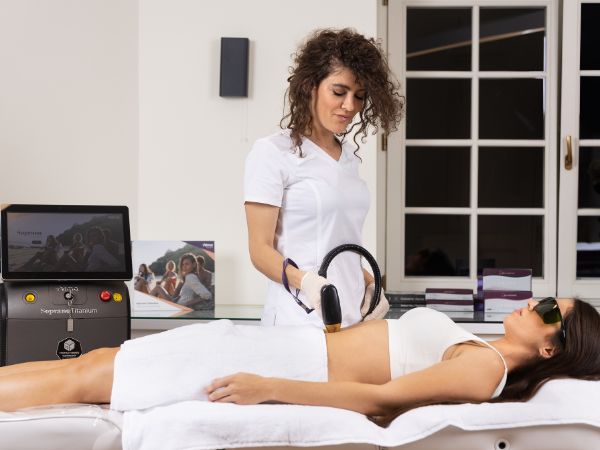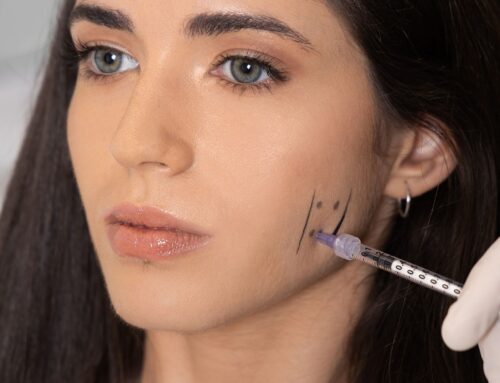Ingrown hairs are a phenomenon accompanied by itching, pain, redness, and often infection and severe inflammation. If we do not treat them adequately, they are no longer just an aesthetic problem, but also a serious health problem. The only permanent, safe and effective solution for ingrown hairs is laser epilation. In this way, you will remove them forever, but also prevent them from appearing again.

Ingrown hairs: what is it about?
Soft, smooth and well-nourished skin is certainly something we all desire. Ingrown hairs can get in the way, and they occur equally in women and men. The consequence of such hairs are dark spots, but also scars on the skin. If you are in the group of people who constantly fight with ingrown and inflamed hairs, you must have wondered why they appear in the first place. More importantly, how to prevent them.
Ingrown hairs, as the name suggests, are those that do not come out to the surface, but go back and grow under the skin. For some people, this can happen once every few months or once a year. In others, this problem can occur constantly and develop into a chronic condition.
The hair that grows under the skin prevents the natural discharge of the sebaceous gland. Because of this, the content of the sebaceous gland remains under the skin and it is easy to get infected and inflamed at the root of the hair, which is professionally called folliculitis .
Unprofessional and unskilled treatment of ingrown hair, attempts to pull it to the surface with tweezers or squeeze it out, will easily lead to various bacterial infections. The skin reacts to ingrown hair as a foreign body, tries to expel it, and therefore various infections and inflammatory processes occur.
the most common causes
Hair growth is a problem that most often appears for the first time during puberty. Then, under the sudden influence of hormones, the activity of the sebaceous glands increases, the hairs grow faster and all this can lead to their ingrowth. After this sensitive period, ingrown hairs can appear in anyone, at any period of life. The reasons that lead to this can be different.
Shaving and waxing the skin are one of the most common causes of ingrown hairs. Due to frequent shaving, the skin can become rougher and sharper, which will make it difficult for the hairs to break through it and come to the surface. This causes the hair to bend and go back under the skin, often resulting in inflammation and infection.
The type of hair and its thickness can also be one of the causes of ingrown hairs and the development of folliculitis. Thicker, dense and curled hairs grow much more often than thinner and straight ones.
As a rule, the hairs in the intimate area are coarser than the hairs on the rest of the body and on the head, which is why ingrown hairs often occur in the bikini area.
Hormonal imbalance, increased sweating, so-called hyperhidrosis, especially in the armpit area, very often directly lead to the appearance of ingrown hairs.
Wearing very tight and tight clothing will cause friction and pressure on the skin, which will contribute to ingrown hairs. Synthetic clothing, as well as sitting for too long, can also be the cause.

Where do ingrown hairs most often occur?
This problem follows both women and men. They can appear on almost all parts of the body that are covered with hair. In women, they usually grow on the most sensitive parts of the skin, under the armpits and in the groin area, and these are the zones that also suffer the most from shaving and waxing. Due to daily shaving, ingrown hairs often appear in men’s cheeks, chin and neck, where they can cause major problems. Small purulent pimples often appear in the infected area. Equally often, they appear on the legs, on the inner side of the thighs, often on the shins, on the glutes, in the back part of the back.
What do ingrown hairs look like?
You might think at first that it’s an inflamed acne or a pimple, because an ingrown hair can really feel that way. Take a closer look and you’ll probably recognize her easily.
Symptoms that accompany hair growth are itching, painful irritation, redness, minor or major swelling. In the place where the hair has grown, a small or large bump will appear, with yellow or white contents. The surrounding skin is swollen, very red. The hair can be seen under the skin or even partially come to the surface. When sebum from the sebaceous gland mixes with bacteria, dead skin cells and impurities, infection and severe inflammation easily occur. When touched, pus and the contents of the sebaceous gland can come out of the infected area. Then the most important thing is not to do anything on your own, not to pull out the hair with a needle or tweezers, not to squeeze or force it out because you will only make the situation worse.
In the event that the ingrown hair does not go away by itself, the swelling is getting bigger, the pain is stronger and the inflammation does not subside, you must consult a doctor. Your doctor may give you a certain antibiotic to calm the inflammation. If the hair needs to be removed, he will make a small incision with a sterile scalpel so that he can bring the hair to the surface and pull it out.
Ingrown hairs: consequences
Hair growth is not at all a naive problem, on the contrary. If ingrown and inflamed hairs are not treated adequately and in a timely manner, serious consequences may occur.
Dark spots, hyperpigmentation , scabs, and scars can all remain on the skin as a result of ingrown hairs.
If the hair becomes inflamed, folliculitis appears, an infectious inflammation of the hair follicle. It is most often caused by bacteria from the genus Staphylococcus , certain viruses and fungi. Folliculitis is all the more dangerous because it can be transmitted from one person to another. Establishing a diagnosis is not difficult, because the doctor is often able to see what it is with the naked eye. In certain cases, it is necessary to take a swab from the infected area. Folliculitis can be acute or chronic, which keeps coming back and whose treatment takes a long time.
One of the very serious health conditions that ingrown hairs can lead to is the so-called pilonidal sinus. This change appears most often in the trich area, and is due to the formation of a channel into which hair grows. Such a subcutaneous channel fills with sweat, sebum, and hairs, and a purulent infection often appears. In 90 percent of cases, it affects men, and in the most severe cases, surgical intervention is required.
Surgeons often refer patients to laser epilation of this area, because it is the only permanent solution and the best prevention of hair growth.
how to remove and prevent them?
When we look at all the consequences that ingrown hairs can leave behind, we are aware that this problem can be very dangerous. That is why it should be solved immediately. Today, there are numerous dermatological and cosmetic solutions that can soothe inflammation and prevent hair growth to some extent. We emphasize that these solutions are only temporary and will not solve the ingrown hair problem forever.
If in your case ingrown hairs occur very rarely, occasionally, then it is best to wait a few days for the inflammation to subside and for the hair to recede on its own. You can possibly apply a warm compress or do a gentle exfoliation to soften the skin and allow the hair to come to the surface. Creams with salicylic acid that will soften ingrown hairs can be helpful. If the inflammation does not subside, seek the help of a dermatologist .
When it is a chronic phenomenon and for whatever reason the hair grows frequently, it is accompanied by inflammation, swelling and pain, then it is necessary to find a long-term solution.
Laser epilation – the only permanent solution for ingrown hairs
The only way to permanently get rid of the problem called ingrown hairs is laser epilation. There is currently no other satisfactory medical topical therapy for this condition. As we said, in addition to being a major aesthetic problem, ingrown hairs can easily lead to numerous complications.
Why is laser hair removal the only way to get rid of ingrown hairs? The answer is very simple: the hairs disappear forever, and the problems you had until then due to their growth disappear forever.
Shaving, waxing or lightening the hairs are all methods that have been overcome nowadays. On the other hand, laser epilation is safe, painless and the most effective method of removing unwanted hair. And the easiest and safest way to perfectly beautiful, well-groomed, smooth and tender skin.
Without allergies, rashes, irritations, laser epilation provides permanent removal of hair on the face and body, both dark and light. Most importantly, it will solve the problem of ingrown hairs forever!

How does laser epilation work on ingrown hairs?
When it comes to ingrown hairs and folliculitis, laser hair removal is the only effective way to get rid of this problem forever. The laser has a therapeutic effect, it penetrates the very root of the hair, removes the hair follicle and destroys it. This is essentially the only way to prevent its growth and infection.
Intense laser beams of the latest generation eliminate and destroy hairs at the very root, by passing through the skin to the hair follicles. The heat emitted by the lasers reaches the pigment of the hair follicle, causing photothermolysis and destruction of the hair, along with its DNA record. This is why the hairs never grow back.
So, if hair growth is something that bothers and burdens you, just a few laser epilation treatments will effectively relieve you of such worries.
IMPORTANT: LASER EPILATION can in certain cases help with acutely ingrown hairs, but if they are under severe inflammation, epilation can only be done after calming down and antibiotic therapy!
What lasers do we use?
In our practice, we want to provide patients with only the best treatments. That’s why we perform laser epilation with medical lasers that are currently among the most sought after on the market, namely Lumenis Lightsheer Desire and Alma Soprano Titanium.
We are talking about lasers of the latest generation, and we emphasize that only these types of medical lasers emit the energy needed to completely remove hair. Only in this way will the results be long-lasting, you will get rid of all unwanted hairs forever, and with them the problem of hair growth will disappear.
Lumenis Lightsheer Desire
Lumenis Lightsheer Desire guarantees maximum hair removal efficiency. It has an optimal wavelength of 805 nm, penetrates the skin and does not damage it. The device is completely safe, reliable, and intended for treating even sensitive skin. The Lumenis Lightsheer Desire laser eliminates more hairs, which is why fewer treatments are needed. It removes up to three times more hair than IPL lasers, and it also has a skin cooling mechanism. This is extremely important precisely in the case of ingrown hairs in sensitive areas, such as the groin, intimate zone, armpits.
Alma Soprano Titanium
Alma Soprano Titanium laser removes all unwanted hair faster than any other laser. Armpit epilation takes only 1 minute, hair from one arm takes 2 minutes, and one leg takes 7 minutes! More than 18 million people have so far eliminated unwanted hair precisely with the Alma Soprano Titanium laser. Its key advantage is in the length of the laser beam it emits, that is, it emits three different wavelengths at the same time. This means that longer and shorter, stronger and weaker hairs can be treated with it at the same time. It is suitable for epilation of all skin types, without fear of damaging the tissue or skin surface. The probe, part of the epilation apparatus, is adapted to all body areas, including the most sensitive and inaccessible ones. You can read all about this laser here.
Is laser hair removal safe?
About 85 percent of women and 70 percent of men today opt for laser epilation when they want to permanently remove hair. The efficiency of laser hair removal is up to 95 percent, so you will tell forever because of the hairs and their ingrowth. It is important that epilation with medical lasers is performed exclusively by trained and certified doctors.
Laser hair removal can be done on all parts of the face and body, except for the area around the eyes, nose and earlobes. The medical laser does not have a harmful effect on the lymph and mammary glands in the case of epilation of the armpits, breasts and groin. It penetrates only a few millimeters under the skin, destroying only the hair follicle. The mammary and lymph glands are located deeper and the laser does not reach them. Our lasers have systems that pleasantly cool the skin, so you can feel only a minimal burning sensation.
4 weeks before the laser epilation itself, it is important not to pull the hairs with tweezers, and do not depilate them either. If you pull them out by the roots, you will only increase the number of treatments. You can remove them by shaving, scissors or depilation cream, and it is important to do this 1-2 days before coming for the treatment. If you are using certain medications, it is important to point this out to our doctor.
How many treatments are needed?
The number of treatments you will need depends on the area you want to epilate, usually 6 to 7 treatments are needed. The first results are already visible after the first treatment. The interval between treatments is usually from 6 to 12 weeks.

price and addition information
You can see the prices of laser hair removal on the Pricelist page. For all the questions you have regarding the elimination of ingrown hairs with laser epilation, feel free to contact us. Schedule an examination, contact us by phone number 064/237-0707 or write to us at imedic.rs@gmail.com.




